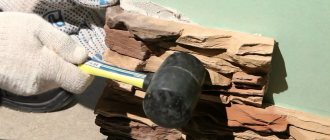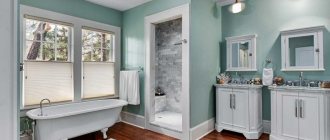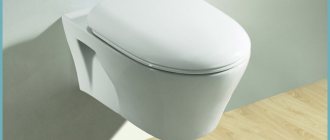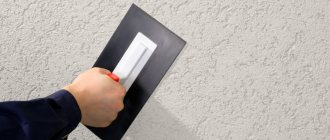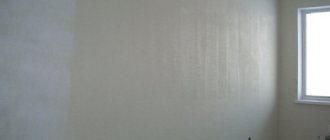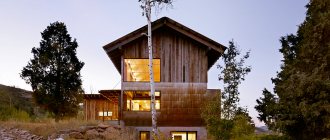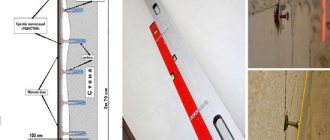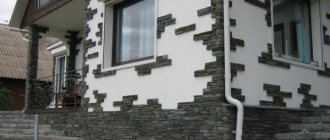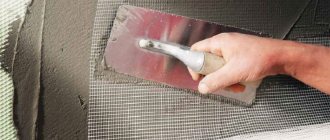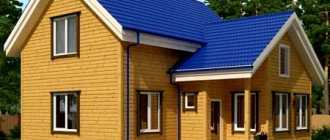Over the past couple of decades, the requirements for building materials regarding their thermal conductivity and insulation abilities have increased significantly. The growing cost of thermal energy, for which you need to pay the market price, forces you to re-arrange thermal insulation even for previously built buildings. We’ll talk about one such technology – heat-insulating plaster (or, more simply, warm plaster) below.
Despite the fact that warm plaster is also used for interior work, it is most often used outside, which imposes a number of restrictions on this material. This information material will be devoted to the composition of the mixture, the nuances of its use, as well as specific brands present on the market.
Insulating plaster – what is it?
Let's look at what warm plaster is. Everyone has long been accustomed to the fact that the classic plaster mixture is a cement-sand mortar containing certain additives. The latter can be lime (to prevent the walls from becoming damp) or all kinds of polymer adhesives (for better adhesion) or even dyes. But what is the mixture for insulating plaster?
In fact, everything is very simple: a filler with a thermal conductivity coefficient significantly lower than that of hardened cement mortar is added to the usual cement-sand mixture (which may also include other polymer components).
Such additives may include:
- expanded vermiculite;
- expanded clay;
- volcanic pumice chips;
- sawdust;
- polystyrene foam granules.
In essence, warm plaster is the same classic plaster mixture that has long been used for finishing buildings and structures, only with additional inexpensive “insulating” components.
Let's sum it up
Warm plaster is used as a leveling building material, similar to its conventional counterparts. The mixtures are also used for treating facades and walls indoors with any humidity. A characteristic feature of this plaster is its heat-insulating property, along with which the coating does not allow noise to pass through.
The affordable cost of warm plaster and a wide range of applications have a clear advantage over analogues. In addition, you can prepare warm plaster with your own hands .
Advantages and disadvantages of warm plasters
New properties are added to the familiar material, and since the laying technology has long been proven and is as cheap as possible, the use of such plaster for thermal insulation of buildings provides considerable economic benefits. And this is the first significant advantage of heat-insulating plaster.
The second interesting quality of this material is that such plaster can be used not only as insulation, but also as a humidity normalizer in the room. Some components (for example, sawdust) are able to absorb excess moisture in the air and release it at a reduced concentration of moisture vapor in the atmosphere. And, in addition, warm plaster is an excellent insulator from moisture, protecting capital structures from its effects.
Thirdly, you can easily make a mixture for warm plaster yourself - for this you just need to have the necessary components on hand.
Let us briefly list other useful properties of warm plasters:
- wear resistance;
- environmental safety and cleanliness;
- resistance to temperature changes;
- due to its high adhesive properties, warm plaster can be applied to almost any surface;
- the array forms a single, integral layer, which practically does not require a reinforcing mesh.
However, to be completely objective, it is worth mentioning the disadvantages of thermal insulating plasters. Compared to specialized insulating materials (for example, mineral wool), warm plaster, no matter what it contains as an insulating component, loses by a noticeable margin. To provide the same level of insulation as a stone wool slab, the layer of warm plaster must be twice as thick.
This is why many people call warm plaster a “half solution.” However, if we take into account its economic benefits and technological simplicity, then such a solution may often be quite sufficient.
Necessity of calculations
Calculations are an integral part of construction work. They allow you to estimate the necessary costs for materials, calculate the minimum layer thickness, and calculate possible heat losses.
Assessing the effectiveness of thermal insulation
Most building materials are divided into thermal insulation and structural. The former have high thermal conductivity. Used for the construction of walls and ceilings. However, in order to meet the standards and obtain low heat exchange with the environment, the construction of thick walls will be required, which is considered economically ineffective. Therefore, to preserve heat, special heat-insulating materials are used, whose heat conductivity is minimal.
Assessing the effectiveness of thermal insulation is necessary to calculate the need for additional insulation of walls, depending on specific climatic conditions. For each climatic region, standard indicators are calculated depending on temperatures in winter and summer. Calculations are carried out for each element of the structure, taking into account its thickness, material of manufacture and location.
Heat transfer resistance depending on region
If the indicator is within the table values, then additional insulation is not required. If the value is less than the standard value, then a special finishing material with suitable thermal characteristics is selected.
Heat loss
An important point in the calculations is taking into account possible heat losses. Data is required not only when selecting insulation for the facade of a building, but also when designing a heating system, choosing a boiler, purchasing and installing heating radiators.
To calculate, you need to know the locations of the greatest heat loss, as well as the method for calculating the loss.
The main heat output currents include:
- window;
- floor;
- walls;
- ventilation;
- roof.
Main types of heat losses
Depending on the specific element of the room, the amount of heat loss will differ. For walls and ventilation it is 20-30%, for floors and roofs within 10-20%, for windows it can reach 25% depending on the number of double-glazed windows.
When calculating, it is necessary to know the area of the structure, thermal resistance and climatic conditions of the region. Beginners are recommended to use a special calculator that makes the necessary calculations. The total area of structures that come into contact with the cold air flow is taken into account.
A special calculator will help you calculate the heat losses of a building or individual room
The obtained value allows you to design the heating so that losses are compensated.
Walls, floors, and ceilings are made of materials with different performance characteristics. Knowledge and ability to calculate thermal conductivity and heat loss when communicating with the external environment make it possible to select suitable finishing materials and create the most energy-efficient room.
Varieties by composition
There are 2 types of heat-insulating plaster mixtures:
- Warm cement plaster. This includes all of the above cement-containing mixtures with the specified additives.
- Foamed plaster. A component is added to the cement-containing mixture that causes the formation of foam when interacting with water. The structure of the solution in this case will be similar to foam concrete in both its raw and hardened form. This type of plaster has significantly higher thermal insulation properties, but it requires mandatory subsequent processing - painting, since the porous structure, like a sponge, can effectively absorb moisture.
Rating of the best
Let's consider several main brands of mixtures for warm plasters:
UMKA® UB-21 TM
Here, ceramic silicon balls are used as a heat-insulating filler. Thanks to the porous structure of this filler, Umka warm plaster provides not only reduced thermal conductivity and a high level of heat conservation, but also high-quality sound insulation. In addition, an array of such plaster has a low specific gravity, due to which it is firmly held on the surface of the capital structure even without a reinforcing mesh.
PALADIUM Palaplaster-207
The sand-cement mixture here contains a special component as a heat-insulating filler - foam glass - a porous but durable filler in the form of granules. It does not contribute to the absorption of moisture vapor from the air, is absolutely “indifferent” to fire, and most importantly, it provides increased heat and sound insulation of the surface of the capital structure.
De Luxe "TEPLOLUX"
The plaster mixture is intended for laying on a concrete base or on foam concrete blocks - it is to these surfaces that the composition demonstrates the maximum degree of adhesion. The mixture contains plaster insulation - 3 mm granules of the same foam concrete (so this property of this plaster mixture is quite understandable).
UNIS TEPLON
This is a variant of gypsum plaster. Gypsum itself is significantly less thermally conductive than solid cement. However, to enhance the thermal insulation properties, perlite (or volcanic glass) granules are added to this mixture.
HAGAst AuBenputzPerlit FS-402
This plaster mixture is based on cement, but also contains perlite, which makes it possible to achieve high sound and heat insulation properties. The mixture is specially intended, mainly for finishing surfaces made of gas and foam concrete.
Knauf Grinband
This thermal plaster contains polystyrene foam granules as an insulating filler, with a fraction of no more than one and a half millimeters. In addition, the mixture contains polymer components that reduce the dispersion of the dried mass and prevent contact of polystyrene granules with moist vapor contained in the atmosphere.
The use of vermiculite for thermal insulation work
To ensure the necessary thermal insulation characteristics of a building, vermiculite can be used in several options:
- In bulk form - for filling the cavities of insulated structures.
- As part of special mortars.
- In the form of ready-made building elements (slabs) made of vermiculite-based composite materials.
The use of vermiculite in the form of backfills
One of the popular methods of using vermiculite is to fill the cavities of insulated structures.
A. Insulation of the roof structure
The figure shows an approximate scheme for insulating a pitched roof, for example, during the construction of a residential attic.
Scheme of insulation of a pitched roof and attic ceiling with vermiculite
1 – rafter legs.
2 – a layer of vapor barrier film that prevents moisture from the premises from penetrating into the insulation layer.
3 – internal lining of the slopes and ceiling of the attic.
4 – frame structure – sheathing for further roofing.
5 – dry vermiculite is poured into the formed cavities.
6 – a wind barrier is laid on top of the insulation - a diffuse membrane that prevents weathering of loose vermiculite and direct contact with water, but does not prevent the free evaporation of moisture.
7 – then, a counter-lattice is installed on top of the membrane, and the roofing material is laid.
b. Insulation of floors
The floor insulation scheme is, in principle, similar.
Insulation of attic floors with vermiculite
A reliable waterproofing material is laid on the hemmed “rough” ceiling between the floor beams, with obligatory overlap of the sheets and sealing of the joints. A sheathing system (joist) is installed for the subsequent laying of the attic floor.
Then, the cavities formed are filled with dry vermiculite. Usually a layer of 100 ÷ 150 mm is sufficient for this.
Vermiculite prices
A diffuse membrane is attached on top of the beams and joists, and then a plank or plywood floor covering is laid (if necessary).
If the attic (attic) is ventilated, moisture will not accumulate in such an insulating layer - it will have free access to evaporation into the atmosphere.
Chief editor of the Stroyday.ru project. Engineer.
Since vermiculite is a fairly expensive material, some owners use a mixture of it with sawdust. Usually the proportions used are either 1:1 or 3:2. It is interesting that when mixed with vermiculite, sawdust “takes over” its resistance to biological decomposition - caking and rotting processes will not be observed in them. This dry mixture can be prepared using a regular construction mixer or a drill attachment.
V. Insulation of hollow walls
When building walls using the “well masonry” technology, it is fashionable to fill the space between the bricks with dry vermiculite. A similar approach can be used when insulating frame walls.
Vermiculite can be poured into the abandoned cavities of multi-layer brick or frame walls...
Backfilling is carried out in stages, as the load-bearing wall and facing layer (sheathing of the frame structure) are erected, with light compaction of the material.
Another option for creating “warm walls” is to fill the voids of building blocks. The thermal insulation effect of such a structure increases sharply, and the noise absorption performance of the wall increases.
...or it fills the voids of building blocks
At the same time, the wall remains “breathable” - the free exchange of vapor in it is not disturbed.
d. Thermal insulation of chimney pipes
An important point when installing a stove or boiler is always the thermal insulation of chimney pipe passages through walls and ceilings. And this problem can be solved very effectively using vermiculite.
Options for thermally insulated chimney pipe passage through ceilings using vermiculite
One option is to install a metal box at the passage point. The resulting cavity between the pipe and the ceiling is filled with dry vermiculite - and thermal insulation of the chimney will be ensured.
Another option is to use through sleeves, which are also filled with vermiculite inside.
The use of vermiculite as a component for construction and finishing mortars
Insulation of vermiculite in the form of dry backfill is highly effective, but still a very expensive solution. Therefore, in the practice of private construction, this material is more often used for the preparation of mortars - this way their thermal insulation characteristics can be significantly increased.
A. Preparation of solutions for screed
If the floor is supposed to be filled with screed, and at the same time it requires additional thermal insulation, it makes sense to use a concrete solution containing a significant proportion of vermiculite for this purpose.
Screed with vermiculite has increased thermal insulation and noise-absorbing properties
To prepare such compositions, standard Portland cement M400, sand and vermiculite with a bulk density of 80 to 150 kg/m³ and a fraction of 0.5 to 5 mm are used. As a result, such a fill will be characterized by a small overall massiveness and pronounced thermal insulation and sound insulation qualities.
There are several tested proportions for the preparation of such solutions. They are selected depending on the required strength and insulating qualities of the coatings being created. The proportions and basic solutions for screeds are presented in the table:
| Mortar proportions (cement sand vermiculite) | Proportion of components per 1 m³ of solution | Density of the solution, kg/m³ | Strength, kg/cm² | Coef. thermal conductivity, W/m×°С | |||
| Cement | Sand | Vermiculite | Compression | Bend | |||
| 1 / 0,5 / 2 | 495 kg | 247 kg | 865 l. | 1000÷1100 | 45 | 24,5 | 0,25 |
| 1 / 0,75 / 2,25 | 430 kg | 320 kg | 895 l. | 1120÷1180 | 35,5 | 30 | 0,28 |
| 1 / 0,75 / 1,75 | 410 kg | 307 kg | 800 l. | 1210÷1275 | 58,5 | 30 | 0,33 |
| 1 / 1 / 2 | 380 kg | 380 kg | 785 l. | 1300÷1350 | 47 | 30,5 | 0,35 |
| 1 / 1,25 / 1,75 | 365 kg | 455 kg | 740 l. | 1400÷1425 | 66 | 32 | 0,41 |
| 1 / 1,65 / 2,5 | 365 kg | 685 kg | 640 l. | 1450-1550 | 72 | 35 | 0,44 |
Due to the fact that vermiculite has increased hygroscopicity, the solution is prepared directly at the place of its use, and must be consumed within 30 minutes from the moment it is mixed with water.
Usually, for reliable insulation of the floor above an unheated room (basement, basement), 100 mm of screed is sufficient. For interfloor ceilings, a layer of 30 mm is sufficient.
When using such compositions, you must remember that in solutions with a cement mass fraction of less than 450 kg/m³, the poured coating will not be frost-resistant - it will withstand no more than 5–7 cycles. So such screeds are recommended exclusively for internal heated rooms.
b. Preparation of masonry mortars
When laying walls, it would be optimal to use materials with increased thermal insulation characteristics - gas silicate blocks, hollow bricks, etc. But the vulnerable area still remains the seams - if the thermal conductivity of the masonry mortar is higher than that of the wall material itself, powerful “cold bridges” are formed in these places, which sharply reduces the thermal performance of the entire structure as a whole.
Masonry joints can become powerful “cold bridges”
The solution is to select solutions in such a way that their thermal conductivity is comparable to that of blocks (bricks). And in this case, vermiculite can again come to the rescue.
The proportional composition of masonry mortars is, in principle, the same as shown in the table above. This means that when choosing a wall material, it is necessary to compare its thermal conductivity indicators with similar parameters of solutions, and choose the closest one in terms of this value. To make it easier, below is a table that shows the thermal conductivity coefficients of the materials most commonly used for laying walls.
| Material type | Density, kg/m³ | Thermal conductivity coefficient, W/m×°С |
| Expanded clay concrete | 1000 | 0.27 |
| Expanded clay concrete | 800 | 0.21 |
| Expanded clay concrete | 600 | 0.16 |
| Expanded clay concrete | 500 | 0.14 |
| Perlite concrete | 800 | 0.16 |
| Perlite concrete | 600 | 0.12 |
| Gas silicate blocks | 1000 | 0.29 |
| Gas silicate blocks | 800 | 0.21 |
| Gas silicate blocks | 600 | 0.14 |
| Foam-gas-ash concrete blocks | 1200 | 0.29 |
| Vermiculite concrete | 800 | 0.21 |
| Vermiculite concrete | 600 | 0.14 |
| Vermiculite concrete | 400 | 0.09 |
| Concrete with polystyrene chips | 600 | 0.145 |
| Concrete with polystyrene chips | 500 | 0.125 |
| Concrete with polystyrene chips | 400 | 0.105 |
| Ceramic brick | 1600 | 0.47 |
| Ceramic brick | 1400 | 0.41 |
| Ceramic brick | 1200 | 0.35 |
| Cement-sand masonry mortar | 1800 | 0.58 |
| Lime-sand masonry mortar | 1600 | 0.47 |
By comparing the data from the two tables, it will not be difficult to determine the optimal composition of the masonry mortar.
V. Production of “warm plasters”
A very effective method of significantly increasing the thermal insulation qualities of walls is the use of so-called “warm plasters” made on the basis of vermiculite.
The use of “warm plasters” with vermiculite is gaining popularity
Such wall coverings have many advantages. First of all, the specific gravity of the plaster layer itself is several times lower than that of traditional compositions. Thermal resistance indicators, on the contrary, are significantly superior. So, for comparison, a layer of only 25 mm will be similar in thermal characteristics to 100 - 150 mm of ordinary cement-sand plaster.
The use of “warm plasters” makes it possible to reduce the thickness of the brick wall being built by about a quarter, without any loss of thermal insulation qualities.
In addition, the soundproofing qualities of the wall structure immediately increase significantly. For ordinary plasters, the sound absorption coefficient is in the range from 0.015 to 0.02, that is, they practically do not resist the spread of noise. For “warm” people this figure is incomparably higher – from 0.2 to 0.65.
For plastering walls, the same compositions that were discussed in the first table can be used. However, there are also lighter solutions that do not use sand at all. The components are only M400 cement and vermiculite with a fraction of 0.5 to 2 mm.
| Plaster mortar parameters | Solution No. 1 | Solution No. 2 |
| Solution proportions: | ||
| — cement, kg | 760 | 600 |
| - vermiculite, l. | 1050 | 1300 |
| - water, l. | 530 | 455 |
| Dry density, kg/m³ | 1100 | 880 |
| Compressive strength, kg/cm² | 50 | 35 |
| Thermal conductivity coefficient, W/m×°С | ||
| - dry | 0.22 | 0.165 |
| — at humidity 5% | 0.27 | 0.22 |
All these plasters are quite suitable for exterior work on almost any wall surface - their adhesion indicators are very good. The frost resistance of such coatings is estimated at approximately 25 cycles.
If you plan to decorate walls or even ceilings with “warm plasters” from the inside of the premises, then you can use modified solutions. Under such operating conditions, high strength indicators are no longer so important, and direct exposure to water on plastered walls is not expected. But the evenness of the coating will certainly come first, for which purpose it is advisable to introduce plasticizing components into the composition of the plaster. In order not to disturb the natural mineral structure of the mixture, lime or purified fine clay can be used as additives that increase plasticity and improve the rubbing ability of the finished surface. “Recipes” for such plasters are given in the table below (“C” - cement, “I” - lime, “G” - clay, “V” - vermiculite):
| The ratio of components in the solution | Approximate consumption per 1m³ of finished solution | Density of the solution, kg/m³ | Compressive strength, kg/cm² | ||||
| C | AND | G | IN | Water, l. | Cement. kg | ||
| 1 | 2 | — | 6 | 400 | 185 | 586 | 8.1 |
| 1 | 3 | — | 8 | 400 | 125 | 581 | 6.7 |
| 1 | — | 2 | 6 | 400 | 185 | 650 | 10.3 |
| 1 | — | 3 | 8 | 400 | 135 | 624 | 8.1 |
Both external and internal plasters with vermiculite have high vapor permeability, which contributes to normal self-regulation of temperature and humidity conditions.
“Warm plasters”, subject to certain rules for their preparation, have another remarkable property - the natural golden or silver tint of vermiculite creates a very interesting decorative effect when finishing facades. It will be especially noticeable in the play of sunlight.
Vermiculite decorative plasters are quite capable of decorating the facade of a house in an original way.
To make plasters decorative, either colored cements are used, or mineral pigments are used with white cement, for example, red lead, ocher, umber and other compounds. The amount of pigment is chosen from 5 to 25% of the total mass of white cement. With minimal consumption, soft pastel colors of facades are obtained. By increasing the pigment content to 15–25%, the facade will receive a bright, rich color.
Approximate recipes for homemade decorative “warm plasters” are given in the table:
| Plaster mortar ingredients | Using white cement and pigments | Using colored cement |
| Cement | 200 kg | 380 kg |
| Lime | 250 kg | — |
| Vermiculite | 1000 l. | 1000 l. |
| Water | 700 l. | 400 l. |
| Plasticizer | — | 0.2 kg |
| Pigment dyes | 20 – 50 kg | — |
You can also purchase a ready-made dry construction mixture - plaster with vermiculite filling. It is prepared immediately before use according to the manufacturer's instructions and applied in accordance with the technological recommendations attached to it. As an example, we can cite two compositions - “TEPLOVER standard” “VERMIX”:
| Name of parameters | "HEATLOVER STANDARD" | "VERMIX" |
| Illustration | ||
| Shelf life of the mortar mixture | up to 4 hours | Up to 2 hours |
| Dry thermal conductivity coefficient, W/m×°C | 0.08 | 0,12÷0,13 |
| Vapor permeability, mg/m×hour×Pa | 0.09 | 0.21 |
| Tensile strength, MPa | ||
| - detached from the base | 0,44 | 0.6 |
| - for compression | 2,19 | 2.3 |
| Time to reach standard values for strength | 28 days | 28 days |
| Frost resistance | F50 | for interior work |
| Brand of mixture by mobility | PC8 | PC3 |
| Permissible thickness of the plaster layer, mm | ||
| - minimum | 10 | — |
| — maximum | 100 | 50 |
| Factory packaging | Paper bag 25 l. (9 kg) | Paper bag 25 or 50 l. (9 or 17 kg) |
| Dry mixture consumption | 1 package per 1 m² with a plaster layer thickness of 25 mm | 9 kg per 1 m² with a plaster layer thickness of 25 mm |
And as a clear example, here is a video presentation of another type of “warm plaster” based on vermiculite:
Where is plaster used for wall insulation?
Thermal insulating plaster can be used for finishing capital structures both indoors and outdoors. Let's consider some features of both formats of its use.
Interior work
To finish the interior surfaces of a building, as a rule, a not too thick layer of plaster is applied. And it’s not at all a matter of the desire to save the useful volume of the premises; it’s just that plaster to insulate the walls from the inside will prevent the internal heat of the house from penetrating into the walls themselves.
What matters here is the so-called dew point, namely its exact location. At what point on the wall of a building does the temperature drop so much that the moisture in the air condenses? Obviously, if this point (or rather, an entire plane) is located inside the solid wall, then this will lead to its erosion - water is extremely dispersed, and its vapors are able to penetrate into all the pores and microcracks of concrete and cement masses. These vapors should not be allowed to turn into liquid (and then possibly freeze) directly inside the wall.
Previously, this was achieved through excessive heating of houses, associated with large energy losses (houses, like giant air heaters, heated the street). Now, heat consumption has been significantly reduced, and plaster on the insulation of internal walls can leave the outer layers of concrete masses “unarmed” from exposure to cold and moisture. Warm plaster is used to insulate walls from the inside, but mainly for the purpose of creating soundproofing of rooms. In this case, its layer should not exceed 30-35 mm.
For example, in Sweden, at the legislative level, there is a ban on insulating residential buildings from the inside (on the scale of private apartments).
External
But for finishing facades, heat-insulating plaster is used very widely. Here its layer, as a rule, is never less than 50 mm, and often reaches 100 mm.
In this regard, there are 2 main nuances:
- Such a mass of plaster must be laid on a reinforcing mesh.
- Dried plaster on top must be painted to prevent the absorption of atmospheric moisture by heat-insulating, but at the same time dispersed granules and materials.
What is vermiculite and what are its main characteristics
Although vermiculite, as an insulation material, is a mineral of natural origin, its beneficial properties, surprisingly, were recognized not so long ago. It was described as a rock only at the end of the 19th century, but it took almost another century for the characteristic features of this mineral to be put at the service of man.
In fact, natural vermiculite is a rock of the silicate class, a group of hydromicas. It differs from ordinary mica in the increased content of water bound in the crystal lattice and the low level of bonds between the layers of the material. Thus, the common molecule of the original, natural vermiculite includes four water molecules “attached” to it.
Fragment of hydromica - raw material for the production of expanded vermiculite
In its normal state, it is a fairly hard rock, with a high density, reaching 2400÷2700 kg/m³, resistant to abrasion, but easily stratified into plates. Its melting point is about 1350 °C. But an interesting feature of the mineral was noticed and used - if it is not brought to melting, but heated to temperatures of the order of 900÷1000 ° C, then the material completely changes its crystal structure. Thin plates swell - increase in size 15-25 times and turn into porous worm-shaped columns or even thin threads with a pronounced golden or silver tint. Apparently, this is where the accepted name of the mineral came from – vermiculite, from the Latin “vermiculus”, which literally means “worm”.
The result is expanded vermiculite - precisely the material that is subsequently widely used in a variety of sectors of construction, industry and agriculture. The air-filled structure has a very low density - it is much lighter than water, and its specific gravity becomes only from 60 to 130 kg/m³.
When fired at high temperatures, pieces of mica turn into layered “worms”
Currently, the production of expanded vermiculite is put on an industrial basis. Our country has rich deposits of the necessary mica rocks - in the Murmansk, Chelyabinsk, Irkutsk regions, in the Krasnodar and Primorsky Territories.
The production cycle consists of several stages. This is raw material sorting, enrichment (removal of ballast impurities), crushing into fine fractions and roasting. The firing process takes a matter of minutes - and then the expanded columns go through the stage of crushing to the desired fraction, followed by sorting, packaging and shipment to consumers.
Prepackaged expanded vermiculite
Vermiculite produced at enterprises must comply with certain standards introduced by GOST 12865-67. So, it is divided into:
- large - grains ranging in size from 5 to 10 mm;
- average - from 0.6 to 5 mm.
– fine – grains up to 0.5 mm.
Chief editor of the Stroyday.ru project. Engineer.
Typically, consumers are supplied with three different grades of material - 200, 150 and 100, in which the numbers indicate the upper limit of the bulk density of the material (kg/m³). The density itself and, accordingly, the insulating qualities of vermiculite depend on the size of the fraction. For example, without going beyond GOST, manufacturing plants offer material with the following parameters:
How to calculate mixture consumption?
As a rule, each manufacturer indicates on the packaging of the plaster mixture the rate of its consumption in terms of 1 m2 of surface to be finished. But if the mixture for plastering is prepared independently, you should keep in mind the average consumption rate (no matter what component composition we are talking about):
25 kilograms of the finished dry mixture when diluted with water should be enough to finish 1-1.4 m2 of wall surface with a 15 mm layer of thermal plaster.
Application technology
Laying a layer of warm plaster is no different from applying traditional plaster. The process consists of 3 parts.
Preparatory stage
At the very beginning, you should prepare the surface. You need to clean it from any dirt, chips, peeling, and fill all cracks with putty. It would be useful to apply a primer layer, which will increase the adhesive ability of the wall.
Preparing the mixture
Each mixture requires its own amount of water for mixing - therefore it is strongly recommended to study the instructions (on the package) before opening it. In addition, some mixtures have a rapid crystallization period after wetting them with water, so you need to be clear about how much time you have for the entire plastering process.
The principle of applying building materials
The plaster material is applied to the wall in layers, each no more than 20 mm thick. In this case, each subsequent layer is applied no earlier than 4 hours after laying the previous one (so that the latter has the opportunity to set).
Definition
Thermal conductivity of a material is the transfer of internal energy from more heated parts to less heated parts. The mechanism of heat transfer differs depending on the state of aggregation of the substance, as well as the temperature distribution over the surface of the material. In other words, the ability of a body to conduct heat is thermal conductivity. It is determined by the amount of heat that is capable of passing through a certain thickness of material in a certain area for a specified time (naturally, for the convenience of calculations, all indicators are equal to one). But plasters differ in the layer of application, which means the indicator will be different
How to make warm plaster with your own hands?
One of the advantageous features of the material in question is that you can make warm plaster for interior or exterior finishing work with your own hands. Let's consider several options for preparing a mixture for heat-insulating plaster:
Plaster mixture using perlite:
- 1 part cement;
- 1 part sand;
- 4-5 parts perlite.
It is permissible to use PVA glue, but not more than 1% of the total volume.
Mixture using plasticizers:
- 1 part cement;
- 2 parts sand;
- 4 parts vermiculite (volcanic glass, which plays the role of a heat-insulating filler in the mixture);
- 50 gr. PVA glue onto a bucket of cement (10 kg).
In both cases, water should be added until the required mixture consistency is achieved.
Dry
There is such a thing as “dry plaster”. For those who don’t know, in construction terminology this means ordinary drywall. Essentially, the sheets are made up of the same elements as regular gypsum plaster (liquid), except that they are dried, pressed, molded and mounted onto cardboard sheets. The thermal conductivity of dry plaster will also depend on the density of the material. The average thermal conductivity coefficient is 0.21.
Limestone
The most common type of plaster for interior work. One of its main qualities can be called pure whiteness, which is perfect for further finishing work, especially painting or applying decorative liquid wallpaper. It consists of a mixture of slaked lime and river sand. Proportions may vary. Thermal conductivity at a density of 1500 kg/m3 will be equal to 0.7.
Each mixture has its own indicators, which are indicated on the packaging. It must be said that a paper bag of dry mixture is an instruction not only for use, but also for its composition. There you can find the basic properties of each composition.
Useful tips and tricks
When applying the plaster mixture, it is extremely important to observe the temperature regime. The composition of warm plaster, due to the presence of a significant amount of filler in it, is less adhesive than classic plaster.
And you need to pay attention:
- on the atmospheric temperature at which work is carried out;
- on the wall temperature;
- on the temperature of the plaster mixture itself.
The ideal option would be if the surface temperature of the wall being finished and the ambient air temperature coincide, and the temperature of the mixture exceeds them by no more than 10°C.
The mixture for warm plaster has a lower specific gravity than the composition of traditional plaster. Therefore, it is necessary to use reinforcing mesh only if a relatively thick layer of this finishing coating is laid (more than 40 mm). And if the wall is plastered without a mesh, the applied mixture should be leveled relative to the pre-set beacons.
Unique qualities
The main advantage of warm plaster is its high plasticity and adhesion (adhesion to the surface). It does not require perfectly smooth walls and performs an additional cosmetic function when decorating a room.
Allows you to insulate slopes, cracks and internal corners where installation of sheet and roll thermal insulation is difficult. There is no need for fasteners that act as “cold bridges” for other materials. The application speed of professional workers reaches 100 m2 in 1 day.
Warm plaster combines environmental friendliness and durability, does not emit volatile compounds and dust.
Reviews
Private reviews regarding the use of warm plaster for interior and exterior work can be found on any Internet portal that has a repair and construction thematic focus. And the best option is to turn to several resources at once (including forum ones). Only in this way can one obtain objective information and form a holistic opinion regarding the qualitative characteristics of a particular type of application of warm plaster in specific conditions.
Vermiculite as insulation: application, pros and cons of the material
In most cases, when we talk about thermal insulation materials used for insulating residential buildings, the first thing that comes to mind is mineral wool in one form or another, expanded polystyrene, expanded clay. Few people remember vermiculite, and many do not even know about its existence.
Vermiculite insulation
And completely in vain. Undeservedly given a “secondary role,” vermiculite is an insulation material of natural origin, the production of which does not use not only harmful, but also no chemical compounds at all. And, at the same time, its thermal insulation and performance qualities are not only comparable, but in some cases seriously exceed those of other widely used insulation materials. In a word, this material deserves to get to know it as closely as possible.

